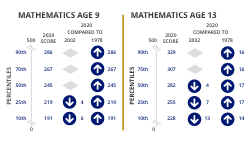Since the 1970s, the National Assessment of Educational Progress (NAEP) has monitored student performance in mathematics and reading through long-term trend (LTT) assessments across three age levels (9-, 13-, and 17-year-old students). These assessments measure students' educational progress over long time periods to look for and monitor trends in performance. NCES decided to administer the LTT assessment for age 9 students−the last NAEP assessment given before the pandemic in March 2020−after two years rather than four years in order to provide pre and postpandemic results for age 9 students in reading and mathematics. The assessments were administered from January to March in 2020 and 2022, respectively. About 7,400 age 9 students from 410 schools participated in each subject in 2022. The focus of the
2022 Age 9 Long-Term Trends Reading and Mathematics Highlights Report is on the comparison of age 9 students (typically in grade 4) between 2020 and 2022. A report summarizing results across the entire trend period will be released in the spring of 2023, along with results for 13-year-old students.





